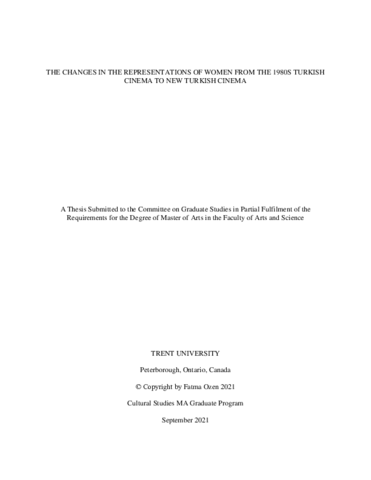Penney, James
The Changes in the Representations of Women from the 1980s Turkish Cinema to New Turkish Cinema
The thesis examines the changes in the representations of women in Turkish cinema from the 1980s through the 2000s in terms of semiotic codes. To demonstrate the shifts of the representations of women over three decades, four films directed by two representative filmmakers of the 1980s and the 2000s are analyzed within the context of gender codes: A Sip of Love (Atıf Yılmaz/1984), The Night, Angel and Our Gang (Atıf Yılmaz/1994), The Third Page (Zeki Demirkubuz/1999) and Envy (Zeki Demirkubuz/2009). Using gender as code in deconstructing women's characteristics and their representations in the films, the research highlights the structural image of women in the semiotic sense. The stereotypical representations in Turkish cinema question social norms, patriarchy, and Islamic norms in Turkey.
Author Keywords: Gender codes, Islam, Patriarchy, Semiotics, The representations of women , Turkish cinema
Nineteenth-Century Aesthetics of Murder: Jack the Ripper to Dorian Gray
This dissertation examines how sex crime and serial killing became a legitimate subject of aesthetic representation and mass consumption in the nineteenth century. It also probes into the ethical implications of deriving pleasure from consuming such graphic representations of violence. Taking off from Jack the Ripper and the iconic Whitechapel murders of 1888, it argues that a new cultural paradigm – the aesthetics of murder – was invented in England and France. To study the 'aesthetics of murder' as countless influential critics have done is not to question whether an act of murder itself possesses beautiful or sublime qualities. Rather, it is to determine precisely how a topic as evil and abject as murder is made beautiful in a work of art. It also questions what is at stake ethically for the reader or spectator who bears witness to such incommensurable violence. In three chapters, this dissertation delves into three important tropes – the murderer, corpse, and witness – through which this aesthetics of murder is analyzed. By examining a wide intersection of visual, literary, and cultural texts from the English and French tradition, it ultimately seeks to effect a rapprochement between nineteenth-century ethics and aesthetics. The primary artists and writers under investigation are Charles Baudelaire, Thomas De Quincey, Oscar Wilde, and Walter Sickert. In bringing together their distinctive styles and aesthetic philosophies, the dissertation opts for an interdisciplinary and comparative approach. It also aims to absolve these writers and artists from a longstanding charge of immorality and degeneracy, by firmly maintaining that the aesthetics of murder does not necessarily glorify or justify the act of murder. The third chapter on the 'witness' in fact, elucidates how writers like De Quincey and Wilde transferred the ethical imperative from the writer to the reader. The reader is appointed in the role of a murder witness who accidentally discovered the corpse on the crime scene. As a traumatized subject, the reader thus develops an ethical obligation for justice and censorship.
Author Keywords: Censorship, Jack the Ripper, Murder, Trauma, Victorian, Wilde
Time, Being, and the Image
The three projects that make up this dissertation try to articulate an ontological idea of art; which is to say, they all approach art, or the imagination (as in project two), from the standpoint of a philosophical question concerning the sense of being. The ontological question is elaborated in terms of a theory of the spatial-temporal structure of the aesthetic or sensible realm. This kind of ontology contrasts with a more traditional metaphysical one, where the sense of being is sought within the purely intelligible realm, a realm that transcends the sensible. In projects one and two, the contrast is developed in terms of the Nietzschean/Heideggerian critique of metaphysics, and through the work of Jean-Luc Nancy, who appropriates this critique. In project three, it is developed in terms of Bergson and Deleuze's critique of objective time, or of any attempt to define being and time in terms of what is static and unchanging. Art is central for the ontology at stake here, and the ontology is one of art, because it is a matter of questioning the spatial-temporal being of the sensible, and not the being of the purely intelligible; and because art (as I try to show) is itself essentially concerned with revealing this ontological dimension of the sensible.
Author Keywords: Aesthetics, Art, Being, Fragment, Image, Time


